Evaluation of the Effects of Rainwater Infiltration on Slope Instability Mechanisms
Abstract
1. Introduction
2. Materials and Methods
2.1. Study Area
2.2. Materials
2.3. Simulation of the Rain Infiltration
Boundary Conditions
2.4. Stability Analysis
- Using a constant parameter φb.
- Using a function of volumetric water content.
3. Results and Discussion
3.1. Precipitation Infiltration Analysis
3.2. Stability Analysis After Rainfall Events
3.3. Behavior of the Slopes in Response to Infiltration
- For the MM slope, moisture conditions with preceding precipitation influenced the pore pressure contours of rainfall events. Unlike the contours observed in moisture conditions without preceding precipitation, positive pore pressures were observed within the slope. The increase in pore pressure over time is associated with a decrease in matric suction [43]. The change in values at a high depth generates a significant change in soil resistance. Thus, the instability of unsaturated soil can be attributed to the reduction in matric suction associated with rainfall infiltration [44].
- The MM slope tends to fail in the unsaturated state, since instability is induced only by rain infiltration that generates positive pore pressures along the surface of the site. A similar result was obtained by [50]. For the author, for slopes that presented inclinations greater than the soil friction angle, stability tends to depend greatly on suction. Therefore, the decrease in suction due to rain infiltration can cause slope failure even in the unsaturated state.
- On the JL slope, rainfall infiltration alone was not sufficient to generate positive pore pressures within the slope and trigger instability. Failure is expected to occur due to the combined effect of rainfall infiltration and rising water tables, which correspond to the development of positive pore pressures together with an increase in the saturation rate within the slope. In a simulation carried out by [51] in Croatia, the slope at the site remained stable during the 167 days of rainfall before the safety factor fell below 1. In the study, although the increase in positive pore pressures along the sliding surface induced failure, ref. [50] found that the unsaturated zone with its storage capacity and low hydraulic conductivity plays the main role in maintaining stability during long periods of rainfall.
- The rectilinear–planar curvature of the JL slope allowed less accumulation of rainwater on the slope surface, reducing the wetting front along the slope and preventing the disappearance of the suction force. Behavior resulted in a safety factor that is in favor of stability.
- Tendencies towards concentration and accumulation of surface runoff in the concave-convergent portions of the MM slope contribute to the reduction in suction and favor soil shearing. Behavior could be one of the contributing factors for the safety factor being unfavorable to stability.
4. Conclusions
Author Contributions
Funding
Institutional Review Board Statement
Informed Consent Statement
Data Availability Statement
Acknowledgments
Conflicts of Interest
References
- Assis Dias, M.C.; Saito, S.M.; Alvalá, R.C.S.; Stenner, C.; Pinho, G.; Nobre, C.A.; Fonseca MR, S.; Santos, C.; Amadeu, P.; Silva, D.; et al. Estimation of exposed population to landslides and floods risk areas in Brazil on an intra-urban scale. Int. J. Disaster Risk Reduct. 2018, 31, 449–459. [Google Scholar] [CrossRef]
- Cai, J.S.; Yeh, T.C.J.; Yan, E.C.; Tang, R.X.; Hao, Y.H.; Huang, S.Y.; Wen, J.C. Importance of variability in initial soil moisture and rainfalls on slope stability. J. Hydrol. 2019, 571, 265–278. [Google Scholar] [CrossRef]
- Liu, J.H.; Chen, Z.M.; He, W. Research of Slope Stability Analysis Considering Rainfall Infiltration. Appl. Mech. Mater. 2012, 204–208, 487–491. [Google Scholar] [CrossRef]
- da Costa Teixeira, E.K.; de Azevedo, R.F.; Ribeiro, A.G.C.; Cândido, E.S. Influence of Rainfall Infiltration on the Stability of a Residual Soil Slope. Electron. J. Geotech. Eng. 2011, 15, 1–16. [Google Scholar]
- Noor, M.J.; Muda, M.A.; Abdul Rahman, A.S. Rainfall induced slope failure detection using infiltration type slope stability method applying non-linear failure envelope. IOP Conf. Ser. Mater. Sci. Eng. 2019, 513, 012013. [Google Scholar] [CrossRef]
- Alessio, P. Spatial variability of saturated hydraulic conductivity and measurement-based intensity-duration thresholds for slope stability, Santa Ynez Valley, CA. Geomorphology 2019, 342, 103–116. [Google Scholar] [CrossRef]
- Schnellmann, R. Uncertainties in the Estimation of Unsaturated Shear Strength from Soil-Water Characteristic Curve. Ph.D. Thesis, Nanyang Technological University, Singapore, 2015. [Google Scholar]
- Zhai, Q.; Rahardjo, H.; Satyanaga, A.; Dai, G.L.; Du, Y.J. Effect of the uncertainty in soil-water characteristic curve on the estimated shear strength of unsaturated soil. J. Zhejiang Univ. Sci. A 2020, 21, 317–330. [Google Scholar] [CrossRef]
- Ibañez, J.P. Modelagem micro-mecânica discreta de solos residuais. Ph.D. Thesis, Universidade Católica do Rio de Janeiro, Rio de Janeiro, Brazil, 2008. [Google Scholar]
- Instituto Brasileiro de Geografia e Estatística. Suscetibilidade a Deslizamentos do Brasil; IBGE: Rio de Janeiro, Brazil, 2019.
- Futai, M.M. Escorregamentos e desastres naturais. In Desastres: Múltiplas Abordagens; Gunther, W.R., Ciccotti, L., Rodrigues, A.C., Eds.; Elsevier: São Paulo, Brazil, 2017; Volume 1, pp. 97–113. [Google Scholar]
- Avelar, A.S.; Netto, A.L.C.; Lacerda, W.A.; Becker, L.B.; Mendonça, M.B. Mechanisms of the Recent Catastrophic Landslides in the Mountainous Range of Rio de Janeiro, Brazil. In Landslide Science and Practice; Margottini, C., Canuti, P., Sassa, K., Eds.; Springer: Berlin/Heidelberg, Germany, 2013. [Google Scholar] [CrossRef]
- Santos, J.A. Análise dos Riscos Ambientais Relacionados às Enchentes e Deslizamentos na Favela São José, João Pessoa—PB. Master’s Thesis, Universidade Federal da Paraíba, João Pessoa, Brazil, 2007. [Google Scholar]
- Gusmão Filho, J.A.; Jucá, J.F.T.; Silva, J.M.J. Mecanismos dos movimentos dos morros de Olinda. Congresso Brasileiro de Mecânica dos Solos e Engenharia Geotécnica, VIII., 1986, Porto Alegre. In Anais do VIII Congresso Brasileiro de Mecânica dos Solos e Engenharia Geotécnica; ABMS: São Paulo, Brazil, 1986; Volume 7. [Google Scholar]
- Marques, J.A.F.; Marques, A.G.; Marques, R.F. Estudos sobre escorregamentos de encostas da formação barreiras de Maceió—AL. In Congresso Brasileiro de Mecânica dos Solos E Engenharia Geotécnica, XVI, Porto de Galinhas. Anais do VIII Congresso Brasileiro de Mecânica dos Solos e Engenharia Geotécnica; ABMS: São Paulo, Brazil, 2012; Volume 7. [Google Scholar]
- Campos, L.E.D. Desastres e ações na Bahia. Conferência Brasileira Sobre Estabilidade de Encostas, VI., 2013, Angra dos Reis. In Anais da VI Conferência Brasileira sobre Estabilidade de Encostas; ABMS: Angra dos Reis, Brazil, 2013. [Google Scholar]
- Santos, O.F.D., Jr.; Silva Filho, F.C.D. Compressão unidimensional de solos residuais da Formação Potengi. Rev. Tecnol. Fortaleza 2009, 30, 97–103. [Google Scholar]
- Elldorf, B.; Melo, R.C. Ação Emergencial para Delimitação de Áreas em Alto e Muito Alto Risco a Inundações e Movimentos de Massa: Areia—PB; Companhia de Pesquisa de Recursos Minerais, Departamento de Gestão Territorial: Brasília, Brazil, 2015.
- Riffel, E.S.; Guasselli, L.A.; Bressani, L.A. Disaster associated with mass movements: A literature review. Bol. Goia. Geogr 2016, 36, 285–305. [Google Scholar]
- Earle, S. Physical Geology, 2nd ed.; Victoria, B.C., Ed.; BCcampus: Victoria, BC, Canada, 2019. [Google Scholar]
- Guerra, A.J.T. Processos erosivos nas encostas. In Geomorfologia: Uma Atualização de Bases e Conceitos; Guerra, A.J.T., Cunha, S.B., Eds.; Bertrand Brasil: Rio de Janeiro, Brazil, 1994; pp. 149–209. [Google Scholar]
- Manfré, L.A. Identificação e Mapeamento de Áreas de Deslizamentos Associadas a Rodovias Utilizando Imagens de Sensoriamento Remoto. Ph.D. Thesis, Universidade de São Paulo, São Paulo, Brazil, 2015. [Google Scholar]
- Santos, E.J. Dos O Complexo Granítico Lagoa das Pedras: Acresção e Colisão na Região de Floresta (Pernambuco), Província Borborema. São Paulo, 1995. 220 p. 2 mapas. Ph.D. Thesis, Universidade de São Paulo, Instituto de Geociências, São Paulo, Brazil, 1995. [Google Scholar]
- Rodrigues, S.W.O.; Medeiros, V.C. Geologia e Recursos Minerais da Folha de Campina Grande, SB.25-Y-C-I, Escala 1:100.000, Estados da Paraíba e Pernambuco; CPRM: Recife, Brazil, 2015; 80p. [Google Scholar]
- EMBRAPA. Sistema Brasileiro de Classificação dos Solos, 5th ed.; EMBRAPA: Brasília, Brazil, 2018; 355p. [Google Scholar]
- Pereira, T.T.C.; Oliveira, F.S.; Freitas, D.F.; Damasceno, B.D.; Dias, A.C. A mineralogia dos solos tropicais: Estado da arte e relação com o uso e manejo. Geonomos 2020, 28, 1–14. [Google Scholar]
- Associação Brasileira de Normas Técnicas. NBR 6457: Amostras de Solo—Preparação Para Ensaios de Compactação e Ensaios de Caracterização; Associação Brasileira de Normas Técnicas: Rio de Janeiro, Brazil, 2016; p. 8. [Google Scholar]
- Associação Brasileira de Normas Técnicas. NBR 6458: Grãos de Pedregulho Retidos na Peneira de Abertura 4,8 mm—Determinação da Massa Específica, da Massa Específica Aparente e da Absorção de Água; Associação Brasileira de Normas Técnicas: Rio de Janeiro, Brazil, 2016. [Google Scholar]
- Associação Brasileira de Normas Técnicas. NBR 6459: Solo—Determinação do Limite de Liquidez; Associação Brasileira de Normas Técnicas: Rio de Janeiro, Brazil, 2017. [Google Scholar]
- Associação Brasileira de Normas Técnicas. NBR 7180: Solo—Determinação do Limite de Plasticidade; Associação Brasileira de Normas Técnicas: Rio de Janeiro, Brazil, 2016. [Google Scholar]
- Associação Brasileira de Normas Técnicas. NBR 7181: Solo—Análise Granulométrica; Associação Brasileira de Normas Técnicas: Rio de Janeiro, Brazil, 2018. [Google Scholar]
- ASTM D4767-11; Standard Test Method for Consolidated Undrained Triaxial Compression Test for Cohesive Soils. ASTM Standards: West Conshohocken, PA, USA, 2011.
- ASTM D 5298-92; Standard Test Method for Measurement of Soil Potential (Suction) Using Filter Paper. ASTM Standards: West Conshohocken, PA, USA, 1992; Volume 15.09, pp. 264–268.
- Geoslope International Ltd. Heat and Mass Transfer Modeling with GeoStudio; Geoslope International Ltd.: Calgary, AB, Canada, 2021. [Google Scholar]
- Aubertin, M.; Mbonimpa, M.; Bussière, B.; Chapuis, R.P. A model to predict the water retention curve from basic geotechnical properties. Can. Geotech. J. 2003, 40, 1104–1122. [Google Scholar] [CrossRef]
- Van Genuchten, M.T. A closed-form equation for predicting the hydraulic conductivity of unsaturated soils. Soil Sci. Soc. Am. J. 1980, 44, 892–898. [Google Scholar] [CrossRef]
- Rahimi, A.; Rahardjo, H.; Leong, E.C. Effect of Antecedent Rainfall Patterns on Rainfall-Induced Slope Failure. J. Geotech. Geoenvironmental Eng. 2011, 137, 483–491. [Google Scholar] [CrossRef]
- Gariano, S.L.; Guzzetti, F. Landslides in a changing climate. Earth Sci. Rev. 2016, 162, 227–252. [Google Scholar] [CrossRef]
- Rahardjo, H.; Satyanaga, A.; Leong, E.C. Effects of Rainfall Characteristics on the Stability of Tropical Residual Soil Slope. In Proceedings of the 3rd European Conference on Unsaturated Soils, Paris, France, 12–14 September 2016. [Google Scholar]
- Morgenstern, N.R.; Price, V.E. The analysis of the stability of general slip surface. Geotechnique 1965, 15, 289–290. [Google Scholar] [CrossRef]
- Vanapalli, S.K.; Fredlund, D.G.; Pufahl, D.E.; Clifton, A.W. Model for the Prediction of Shear Strength with respect to Soil Suction. Can. Geotech. J. 1996, 33, 379–392. [Google Scholar] [CrossRef]
- Cunha, J.L.X.L.; Coelho, M.E.H.; de Albuquerque, A.W.; Silva, C.A.; da Silva, A.B., Jr.; de Carvalho, I.D.E. Water infiltration rate in Yellow Latosol under different soil management systems. Rev. Bras. Eng. Agrícola E Ambient. 2015, 19, 1807–1929. [Google Scholar] [CrossRef]
- Abd, I.A.; Fattah, M.Y.; Mekkiyah, H. Relationship between the matric suction and the shear strength in unsaturated soil. Case Stud. Constr. Mater. 2020, 13, 2214–5095. [Google Scholar] [CrossRef]
- Oh, W.T.; Vanapalli, S.K.; Qi, S.; Han, Z. Estimation of the variation of matric suction with respect to depth in a vertical unsaturated soil trench associated with rainfall infiltration. In Proceedings of the 3rd European Conference on Unsaturated Soils, Paris, France, 12–14 September 2016. [Google Scholar]
- Ghadrdan, M.; Shaghaghi, T.; Tolooiyan, A. The effect of negative excess pore-water pressure on the stability of excavated slopes. Géotech. Lett. 2019, 9, 20–29. [Google Scholar] [CrossRef]
- van Oosterhout, M.J. Differences in Soil Water Characteristics of Monoculture Oil Palm Plantations, Agroforestry Oil Palm Plantations and Natural Forest; University of Twente: Enschede, The Netherlands, 2022. [Google Scholar]
- Cho, S.E. Probabilistic stability analysis of rainfall-induced landslides considering spatial variability of permeability. Eng. Geol. 2014, 171, 11–20. [Google Scholar] [CrossRef]
- Shao, W. Numerical Modeling of the Effect of Preferential Flow on Hillslope Hydrology and Slope Stability. Master’s Thesis, Delft University of Technology, Hongkong, China, 2017. [Google Scholar] [CrossRef]
- Vaughan, P.R. Characterizing the mechanical properties of in situ residual soil. In Proceedings of the 2nd International Conference on Geomechanics in Tropical Soils, Singapore, 12–14 December 1988. [Google Scholar]
- Gallage, C.; Abeykoon, T.; Uchimura, T. Instrumented model slopes to investigate the effects of slope inclination on rainfall-induced landslides. Soils Found. 2021, 61, 160–174. [Google Scholar] [CrossRef]
- Peranić, J.; Jagodnik, V.; Arbanas, Ž. Rainfall infiltration and stability analysis of an unsaturated slope in residual soil from flysch rock mass. In Proceedings of the XVII European Conference on Soil Mechanics and Geotechnical Engineering, Reykjavik, Iceland, 1–6 September 2019. [Google Scholar]
- Silva, A.M.D.; Schulz, H.E.; Camargo, P.B.D. Hidrossedimentologia em Bacias Hidrográficas, 2nd ed.; RIMA: São Carlos, Brazil, 2007. [Google Scholar]
- Silva Neto, J.C.A. Avaliação da vulnerabilidade à perda de solos na bacia do rio Salobra, MS, com base nas formas do terreno. Geografia 2013, 22, 5–25. [Google Scholar]



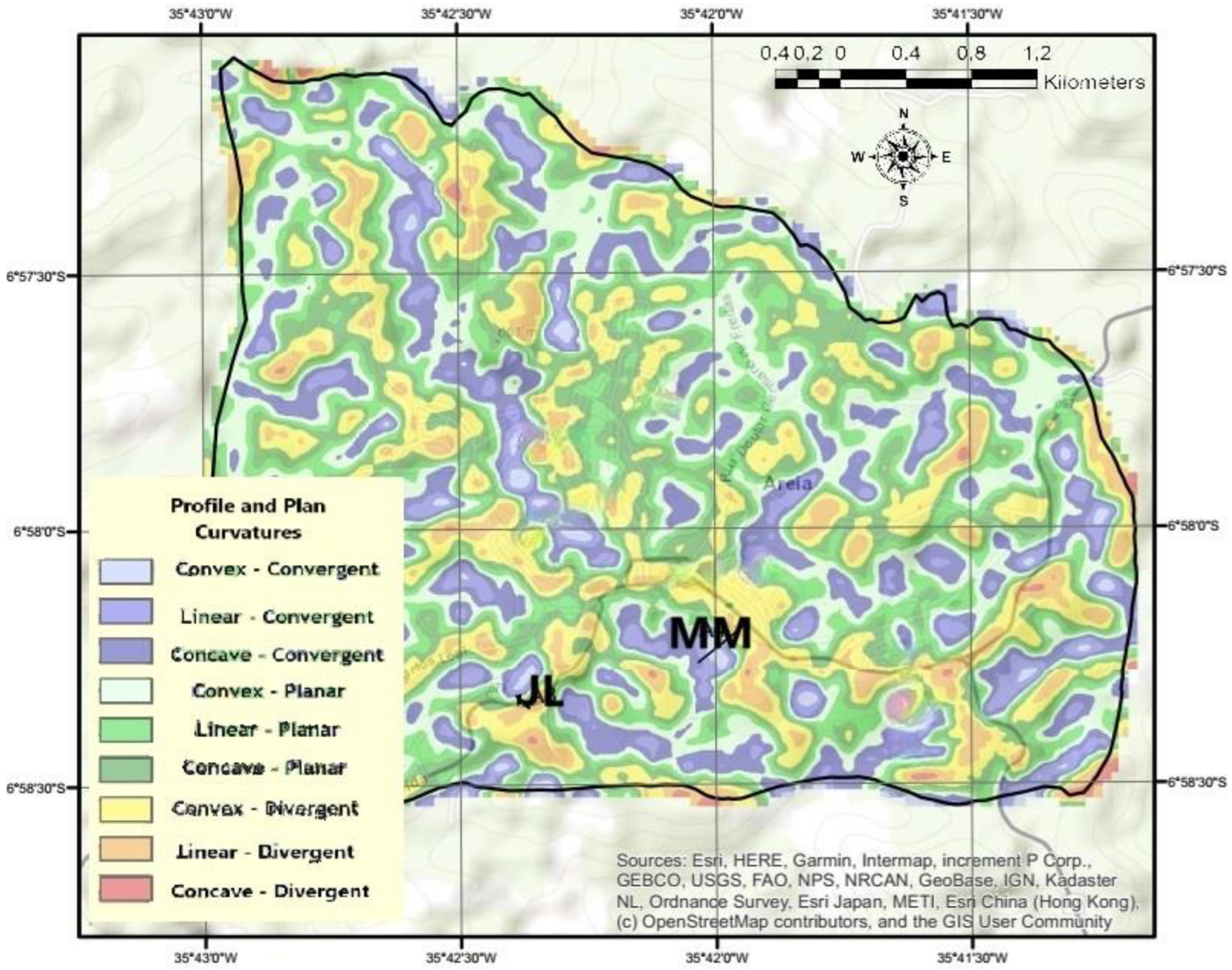
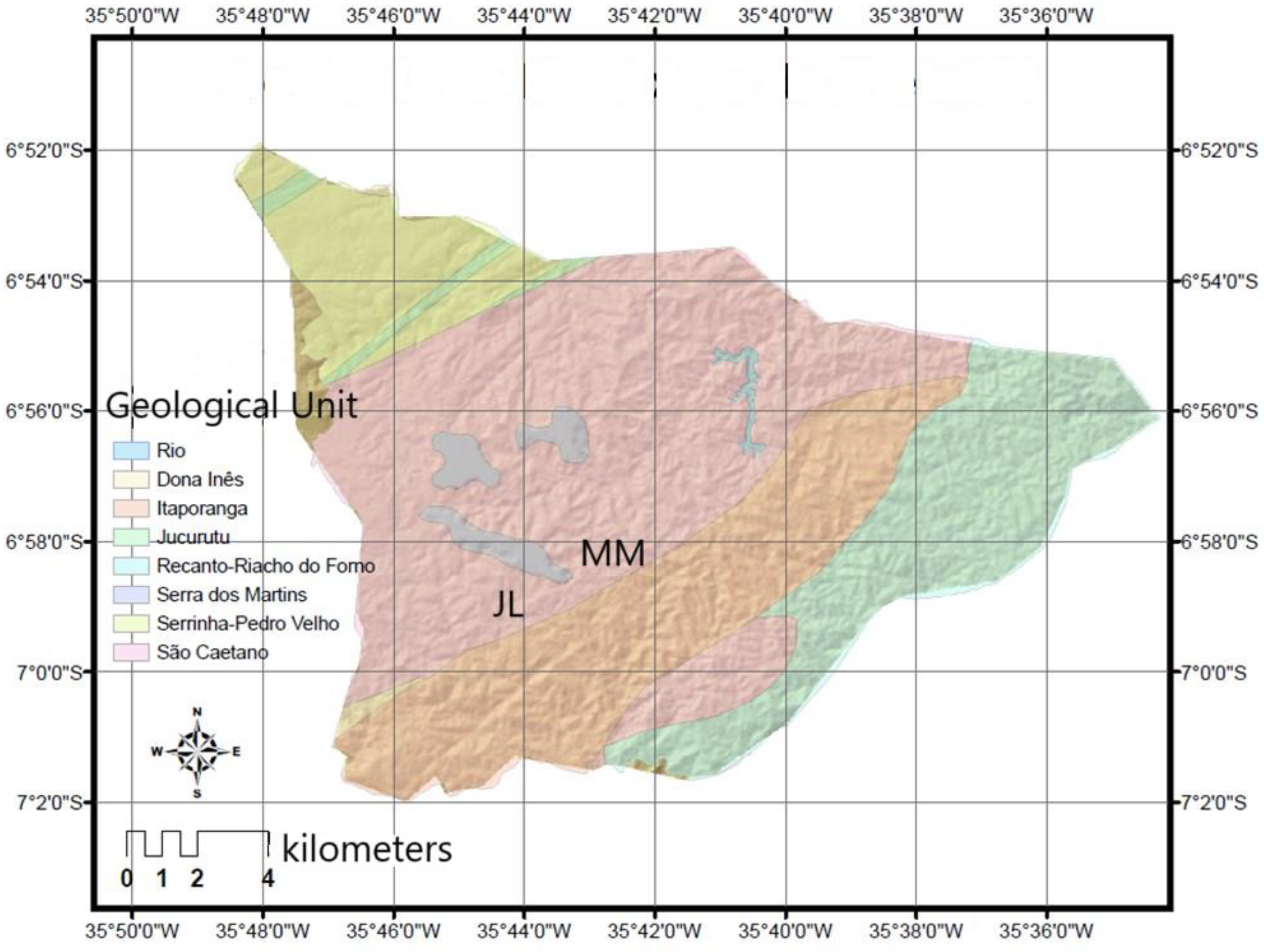


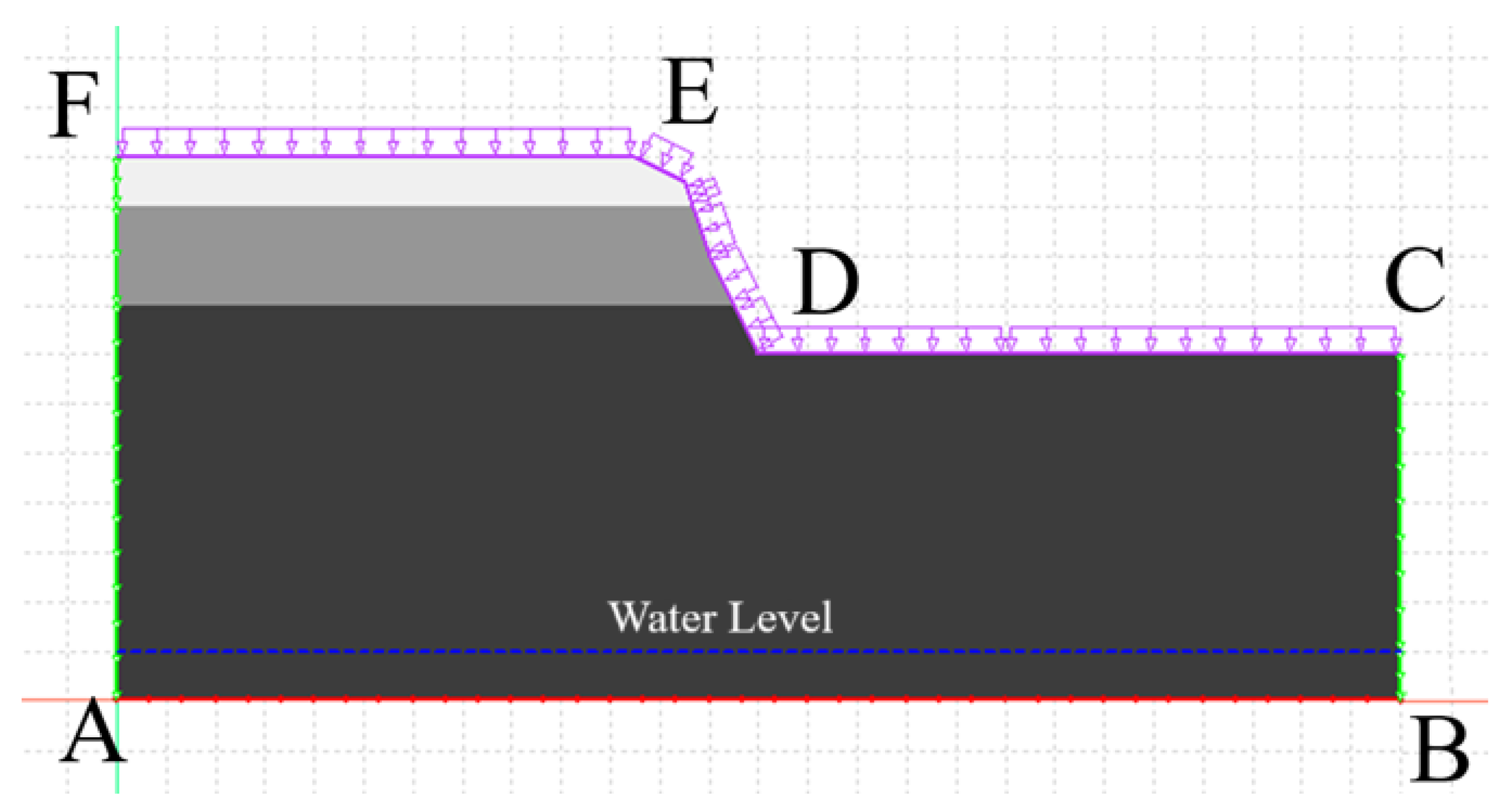
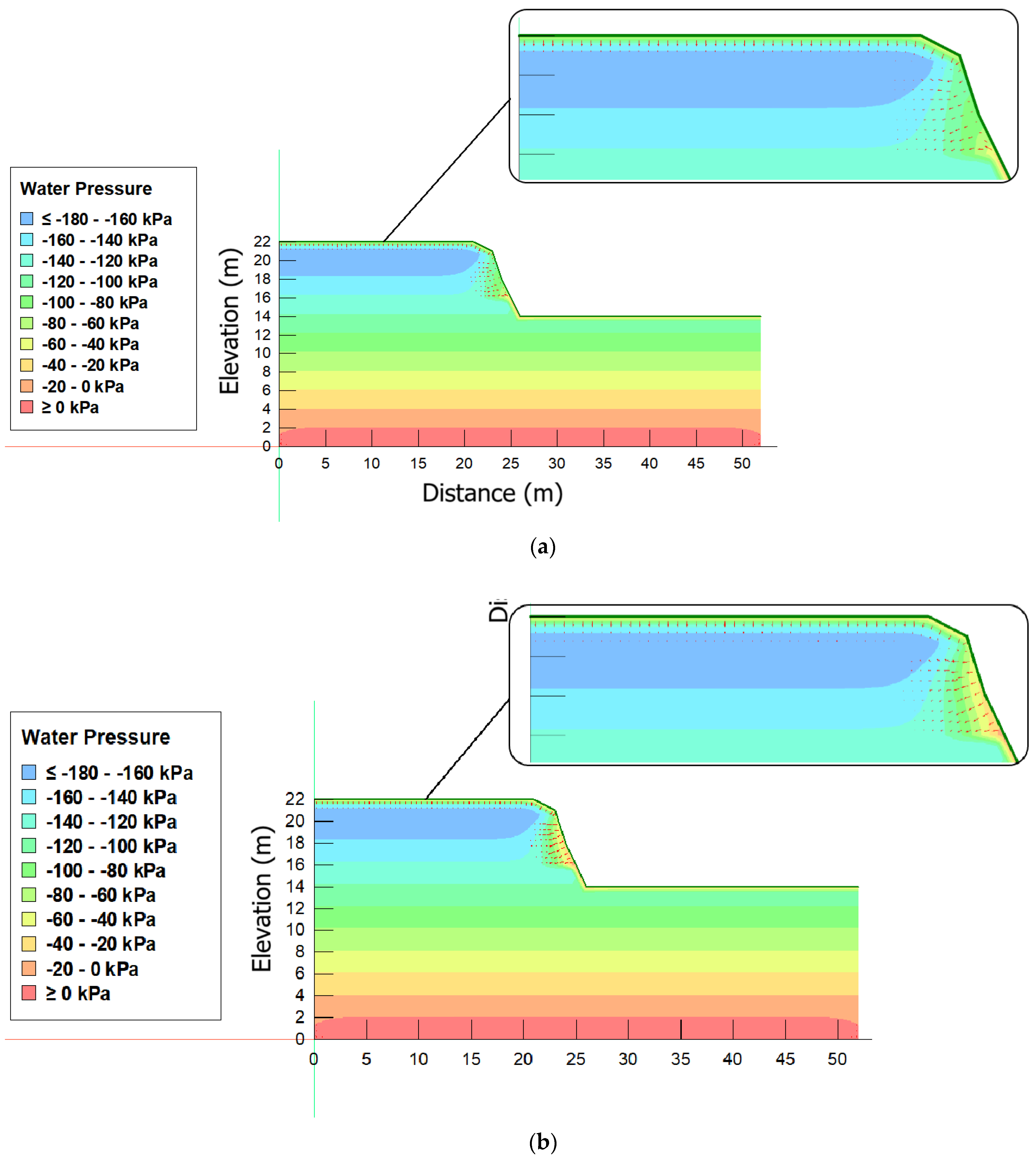
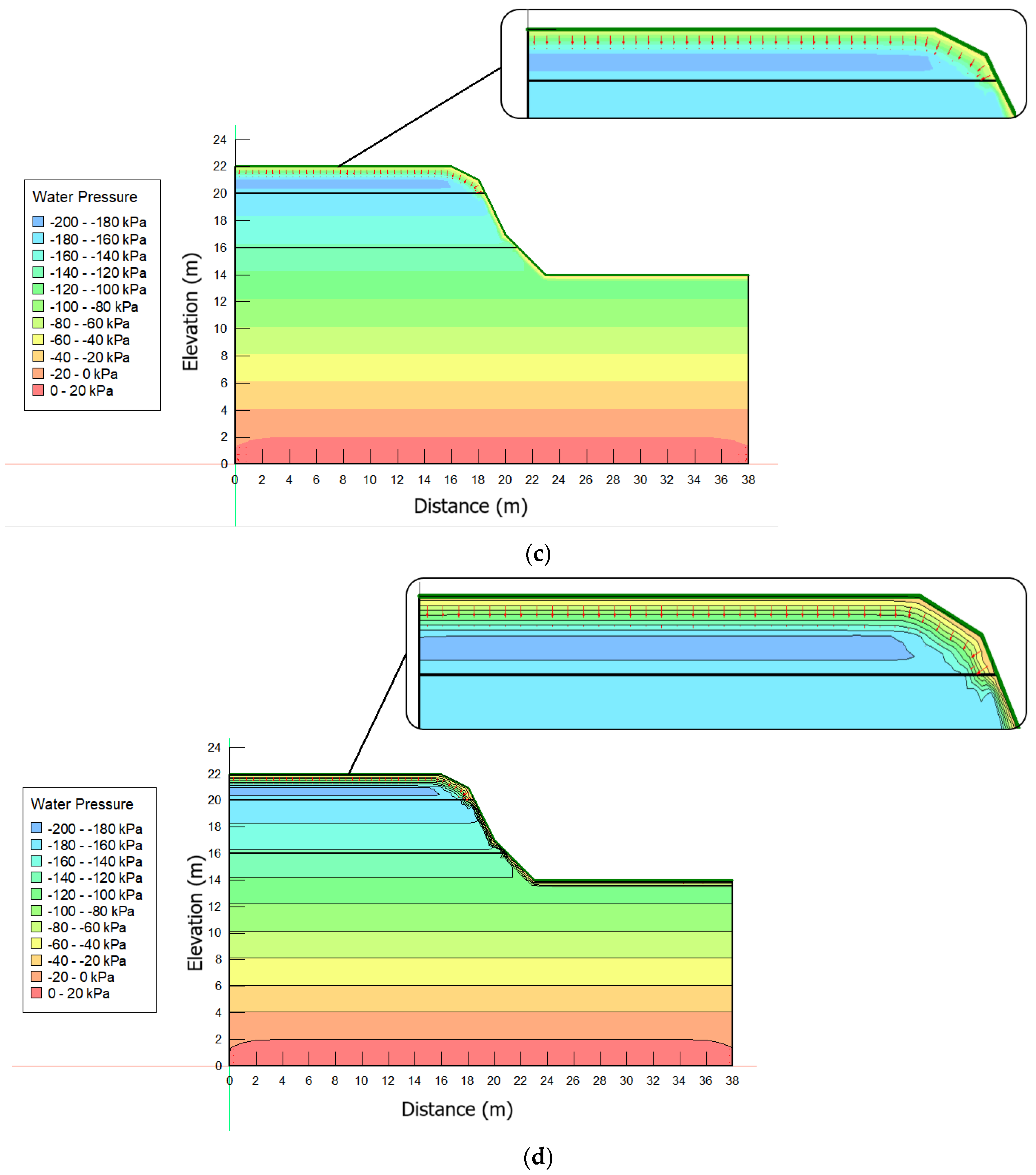
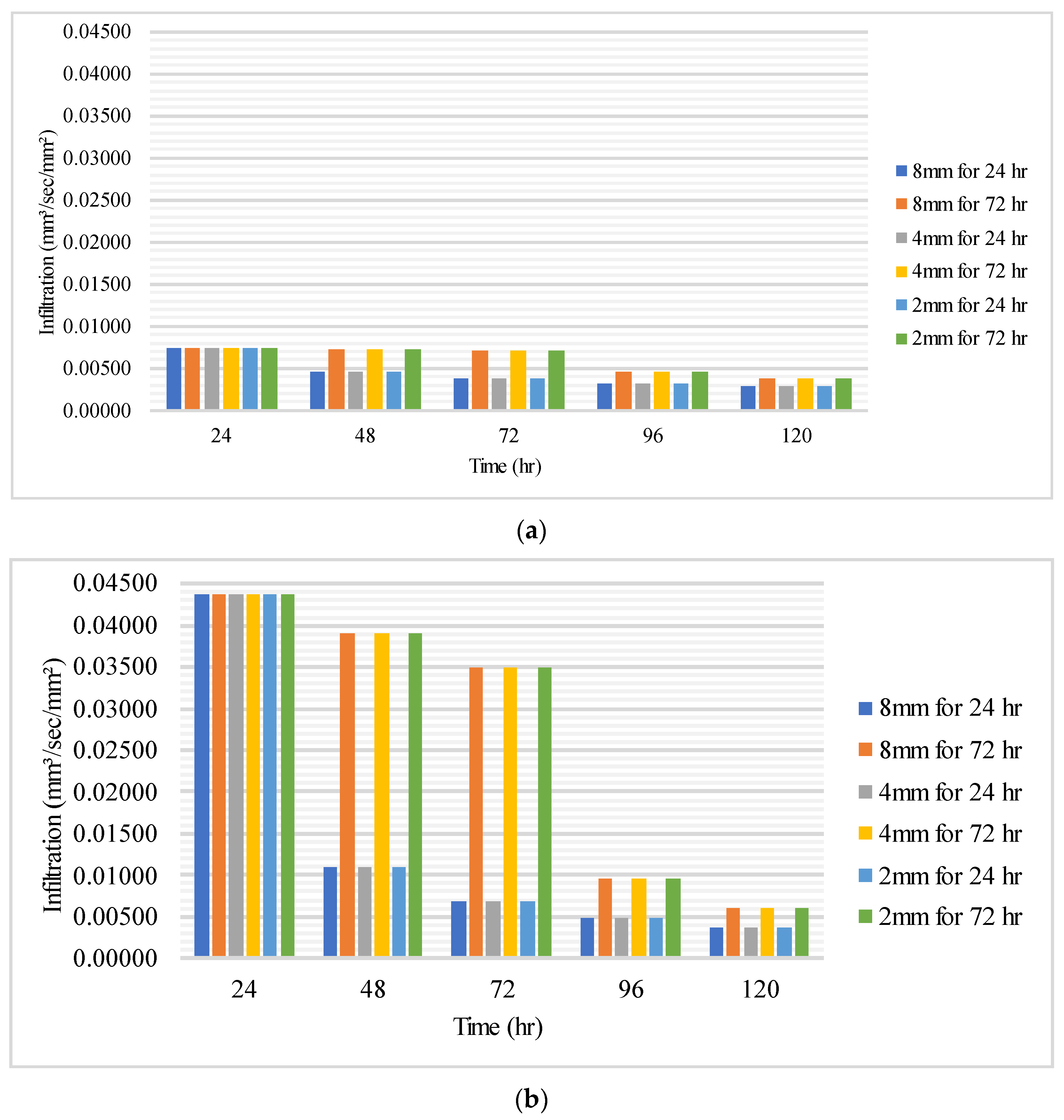

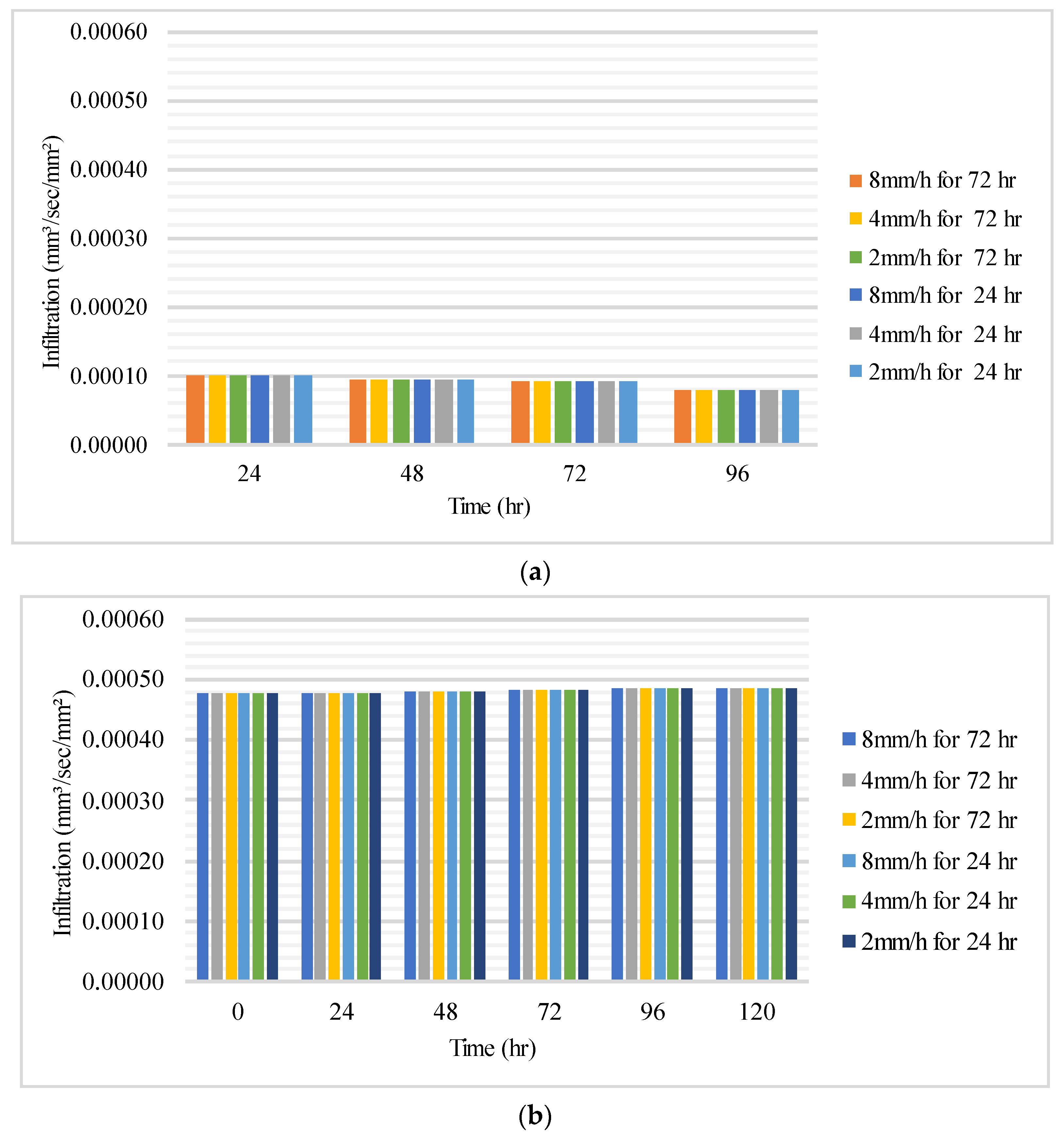
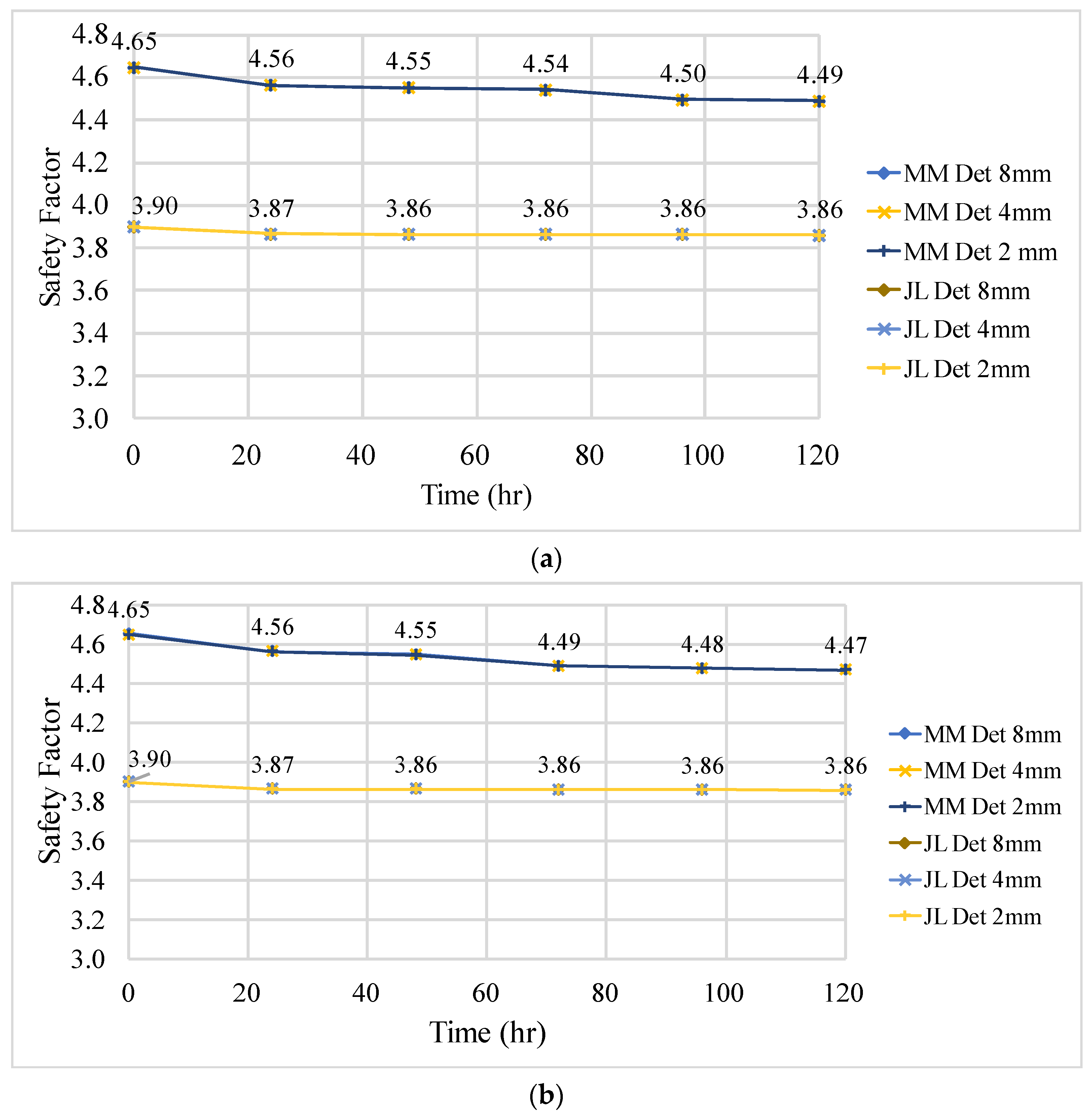


| Analysis | MMT | MMC | MMB | JLT | JLC | JLB | |
|---|---|---|---|---|---|---|---|
| Granulometry | Clay | 16% | 26% | 36% | 39% | 67% | 53% |
| Silt | 19% | 36% | 27% | 16% | 9% | 17% | |
| Sand | 55% | 35% | 37% | 43% | 24% | 30% | |
| Gravel | 10% | 3% | 1% | 2% | 1% | 1% | |
| Consistency index | % LL | 39 | 43 | 47 | 43 | 50 | 51 |
| % PL | 30 | 31 | 32 | 30 | 39 | 43 | |
| % IP | 9 | 12 | 15 | 13 | 11 | 8 | |
| Specific gravity of grains (g/cm3) | 2.69 | 2.80 | 2.69 | 2.60 | 2.71 | 2.57 | |
| Soil | MMT | MMC | MMB | JLT | JLC | JLB |
|---|---|---|---|---|---|---|
| ϕ (º) | 33.14 | 39.23 | 31.39 | 35.19 | 28.57 | 24.27 |
| c’ (kPa) | 15 | 3 | 21 | 11 | 17 | 20 |
| Area | MM | JL | ||
|---|---|---|---|---|
| Rainfall duration | 24 h | 72 h | 24 h | 72 h |
| Safety factor | 0.85 | 0.85 | 1.54 | 1.54 |
| Infiltration rate (mm3/s) | 4.8 × 10−4 | 4.8 × 10−4 | 9.94 × 10−5 | 9.94 × 10−5 |
| Slope (°) | 63.4 | 63.4 | 71.6 | 71.6 |
| Pore pressure (kPa) | 11.59 | 11.59 | 0.42 | 7.76 |
| Friction angle (°) | 39 | 39 | 35 | 35 |
| Cohesive intercept (kPa) | 3.4 | 3.4 | 19.7 | 19.7 |
| Suction strength (kPa) | 0.00 | 0.00 | 12.33 | 12.33 |
| Hydraulic conductivity (m3/s) | 1.50 × 10−8 | 1.50 × 10−8 | 3.84 × 10−9 | 3.85 × 10−9 |
| Curvature along the slope | concave–convergent | rectilinear–planar | ||
Disclaimer/Publisher’s Note: The statements, opinions and data contained in all publications are solely those of the individual author(s) and contributor(s) and not of MDPI and/or the editor(s). MDPI and/or the editor(s) disclaim responsibility for any injury to people or property resulting from any ideas, methods, instructions or products referred to in the content. |
© 2024 by the authors. Licensee MDPI, Basel, Switzerland. This article is an open access article distributed under the terms and conditions of the Creative Commons Attribution (CC BY) license (https://creativecommons.org/licenses/by/4.0/).
Share and Cite
Lira, B.S.; dos Santos Junior, O.F.; de Freitas Neto, O.; Sousa, M.N.d.M. Evaluation of the Effects of Rainwater Infiltration on Slope Instability Mechanisms. Sustainability 2024, 16, 9530. https://doi.org/10.3390/su16219530
Lira BS, dos Santos Junior OF, de Freitas Neto O, Sousa MNdM. Evaluation of the Effects of Rainwater Infiltration on Slope Instability Mechanisms. Sustainability. 2024; 16(21):9530. https://doi.org/10.3390/su16219530
Chicago/Turabian StyleLira, Bruna Silveira, Olavo Francisco dos Santos Junior, Osvaldo de Freitas Neto, and Maria Natália de Melo Sousa. 2024. "Evaluation of the Effects of Rainwater Infiltration on Slope Instability Mechanisms" Sustainability 16, no. 21: 9530. https://doi.org/10.3390/su16219530
APA StyleLira, B. S., dos Santos Junior, O. F., de Freitas Neto, O., & Sousa, M. N. d. M. (2024). Evaluation of the Effects of Rainwater Infiltration on Slope Instability Mechanisms. Sustainability, 16(21), 9530. https://doi.org/10.3390/su16219530







